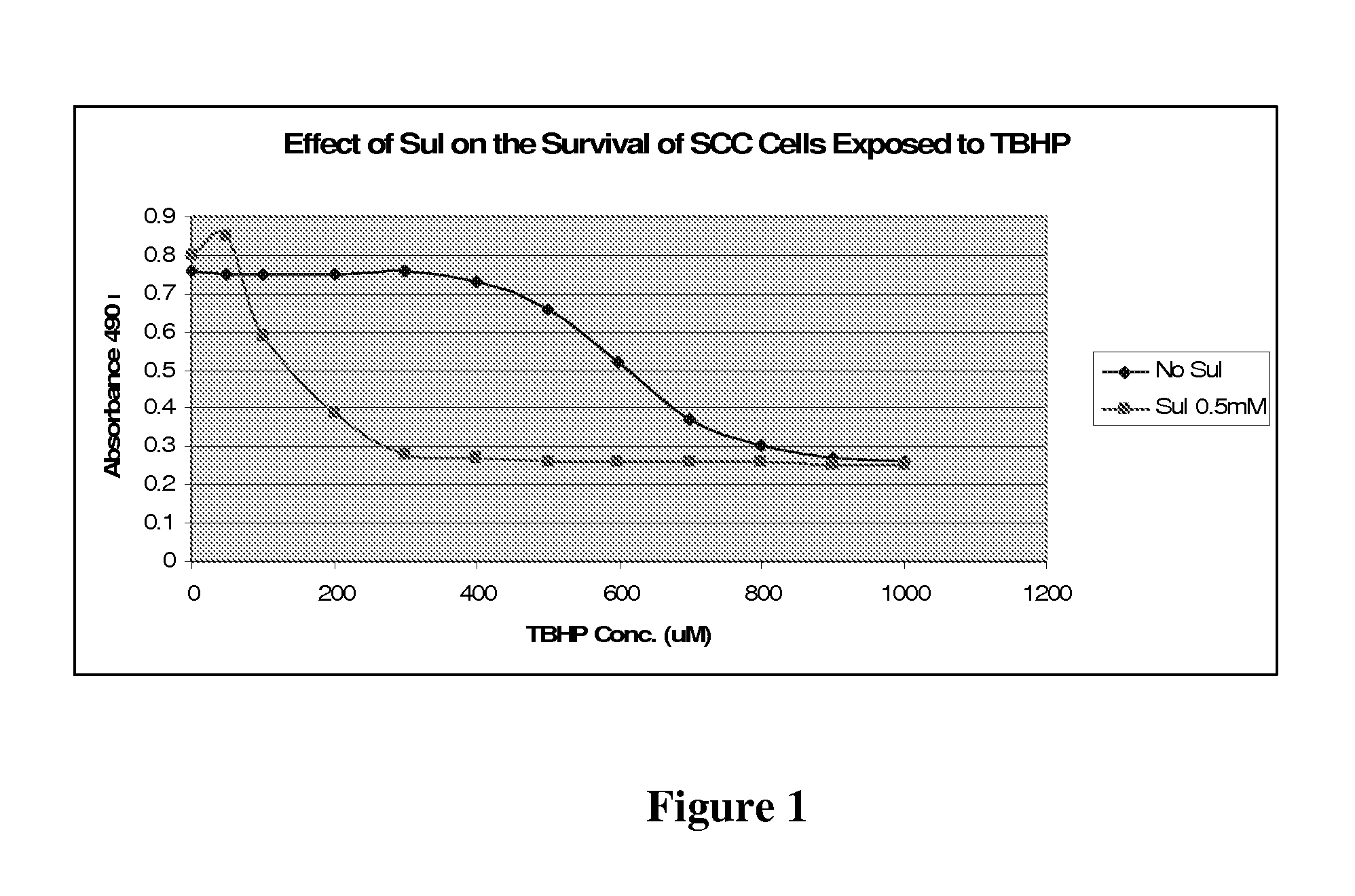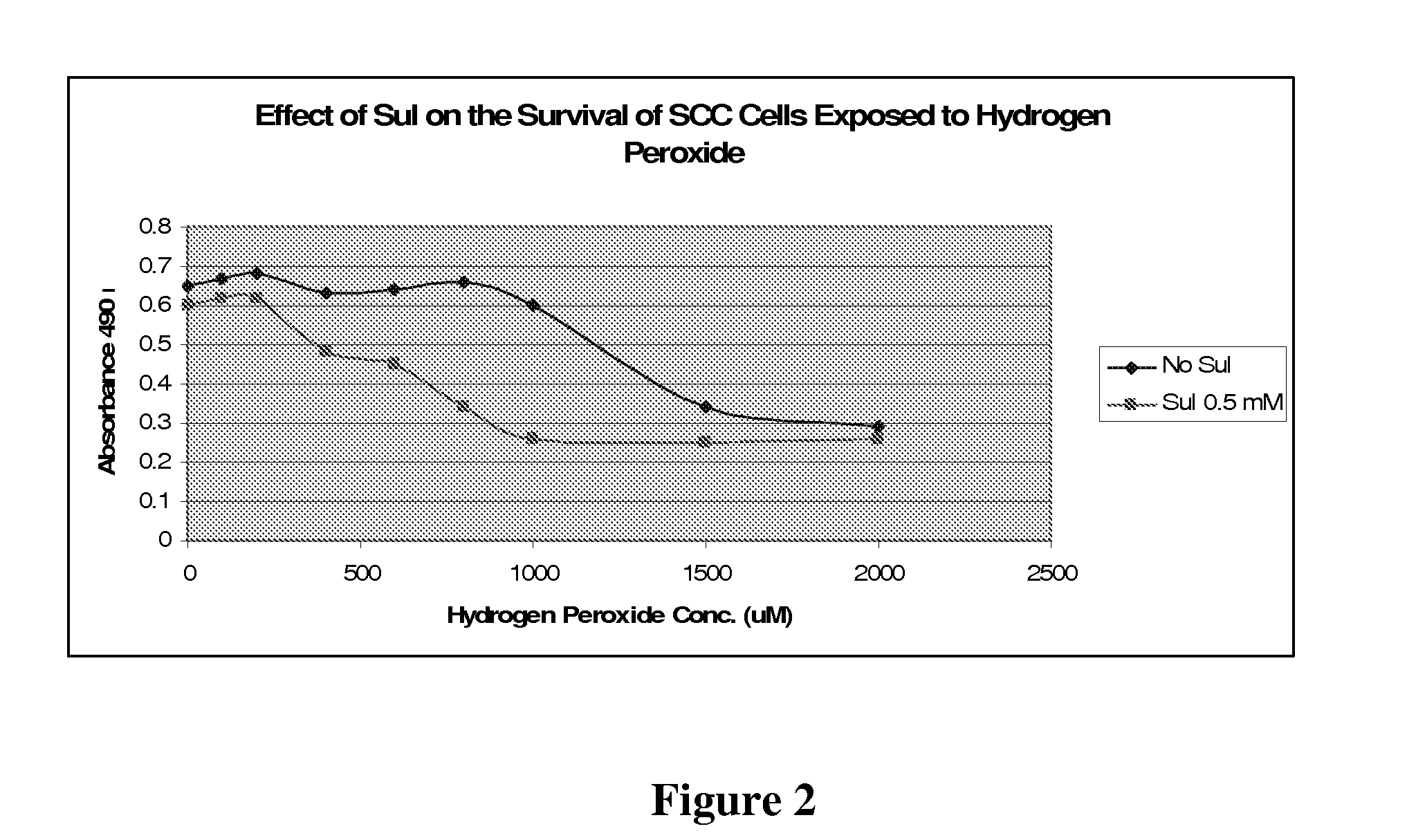Treatment or prevention of cancer and precancerous disorders
a cancer and precancerous disease technology, applied in the field of cancer or precancerous disease treatment or prevention, can solve the problems of not always practical or desirable surgery, unfavorable surrounding normal skin, and inability to surgically remove skin cancers and actinic keratoses, etc., to achieve effective removal of lesions, no effect on surrounding normal skin, and enhanced killing of cancer cells
- Summary
- Abstract
- Description
- Claims
- Application Information
AI Technical Summary
Problems solved by technology
Method used
Image
Examples
example 1
[0215]Sulindac enhances the killing of the human SCC-25 squamous cell skin cancer cell line by tert-butyl hydroperoxide (TBHP). SCC-25 is a human squamous cell carcinoma cell line developed by J G Rheinwald [Rheinwald, 1981]. The cells are obtained from the American Type Culture Collection (ATCC # CRL-1628). The cells were maintained in minimum essential medium (Eagle) supplemented with 2 mM L-glutamine, Earle's BSS containing 1.5 g / L sodium bicarbonate, 0.1 mM non-essential amino acids, 1.0 mM sodium pyruvate and 10% fetal bovine serum.
[0216]The experimental approach was to pretreat SCC cells with sulindac for 24 hr prior to exposure to TBHP for 2 hr. Sulindac (Sigma; S-8139) was freshly prepared as a IM stock solution in 1M Tris.Cl, pH 8.0. SCC cells were suspended in culture medium containing 10% fetal bovine serum at a cell density of 6×105 cells / ml. Cell suspensions containing 500 μM sulindac or no sulindac (Control) were plated in 96 well microtiter...
example 2
Killing of Colon Cancer Cells
[0225]Sulindac enhances the killing of the RKO colon cancer cell line by tert-butyl hydroperoxide (TBHP). RKO is a human colon carcinoma cell line developed by Michael Brattain [Brattain, 1984]. The cells were obtained from the American Type Culture Collection (ATCC #CRL-2577). The cells were maintained in minimum essential medium (Eagle) supplemented with 2 mM L-glutamine, Earle's BSS containing 1.5 g / L sodium bicarbonate, 0.1 mM non-essential amino acids, 1.0 mM sodium pyruvate and 10% fetal bovine serum.
[0226]Experiments were performed with the RKO colon cancer cells that were pretreated with 500 μM sulindac using TBHP. The combination of pretreatment with sulindac and oxidative stress by addition of TBHP enhanced the killing of the RKO carcinoma cells (FIG. 4). The decrease in viability of RKO cells pretreated with 500 μM sulindac was statistically “very significant” (P<0.005) at all concentrations of TBHP from 120 μM to 300 μM, the highest concentra...
example 3
[0230]Sulindac enhances the killing of a lung carcinoma cell line by TBHP. Experiments using similar methods were performed with a lung carcinoma cell line designated A549. The cell line is obtained from the American Type Culture Collection (ATCC #CCL 185). The line was established by D. J. Giard using an explant of lung carcinomatous tissue from a 58-year-old Caucasian male [Giard, 1973]. Cells were grown in Ham's F12K medium supplemented with final concentrations of 2 mM L-glutamine, 1.6 g / L sodium bicarbonate and 10% fetal bovine serum. Cultures were maintained between 6×103-6×104 cells / cm2 in standard tissue culture flasks. The protocol for pretreatment of cells with 500 μM sulindac followed by a two hour exposure to various concentrations of TBHP was the same as that described for the RKO colon cancer cells.
[0231]Following a 24 hr pretreatment with 500 μM sulindac, the cells were washed once to remove the excess sulindac before exposure to TBHP for 2...
PUM
| Property | Measurement | Unit |
|---|---|---|
| flow rate | aaaaa | aaaaa |
| pH | aaaaa | aaaaa |
| delay time | aaaaa | aaaaa |
Abstract
Description
Claims
Application Information
 Login to View More
Login to View More - R&D
- Intellectual Property
- Life Sciences
- Materials
- Tech Scout
- Unparalleled Data Quality
- Higher Quality Content
- 60% Fewer Hallucinations
Browse by: Latest US Patents, China's latest patents, Technical Efficacy Thesaurus, Application Domain, Technology Topic, Popular Technical Reports.
© 2025 PatSnap. All rights reserved.Legal|Privacy policy|Modern Slavery Act Transparency Statement|Sitemap|About US| Contact US: help@patsnap.com



